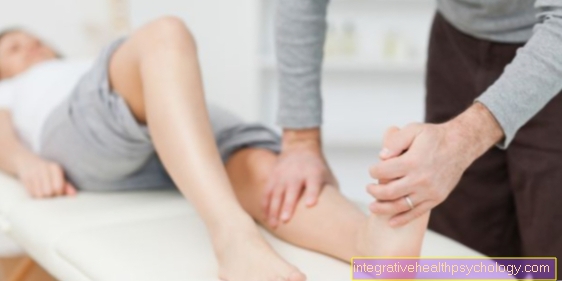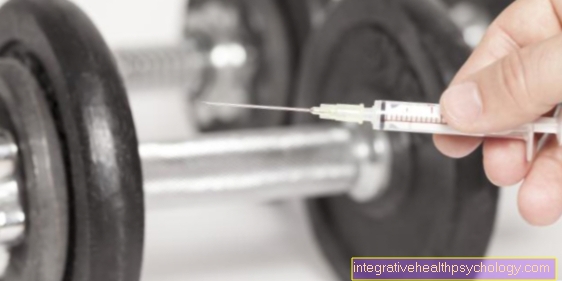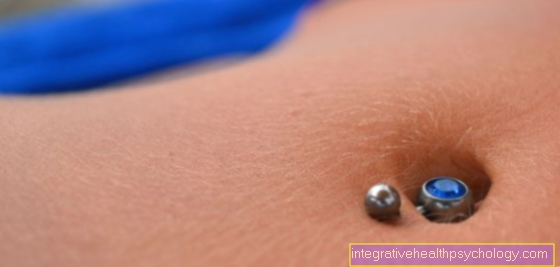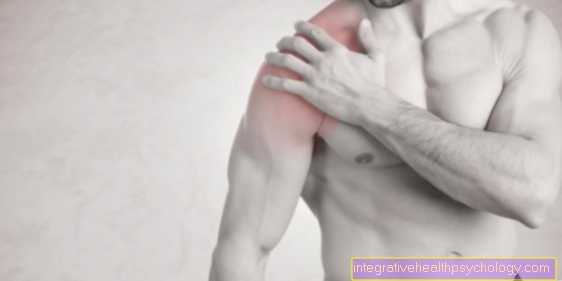Dislocation of the finger joint
definition
The term "finger joint dislocation" or "dislocated finger joint" is the colloquial term for the Dislocation of a finger joint. When a joint is dislocated, the bones jump out of the joint.

introduction
A sub-form of dislocation is the Subluxationin which the bones do not jump out of the joint completely, but rather the position of the bones within the joint shifts. The dislocation of a finger joint usually happens due to a sudden and strong application of force, as in a fall, but can also happen spontaneously without external force. Dislocating a finger joint is very painful. Not only the finger joints can be affected by a dislocation: The shoulder is the joint that most frequently dislocates, Elbow and Kneecap are also often affected. The finger joints are less likely to be affected by a dislocation. A finger has a total of three joints: That Base joint at the transition to the hand that medium- and the End joint. Any of these joints can be affected by a dislocation.
root cause
Several bones are in contact in a joint. They are covered with cartilage on the contact surfaces to protect the bone material. The communication between the bones takes place within the joint cavity, which is surrounded by a joint capsule. Each joint is secured by ligaments, muscles and tendons.
When a finger joint is dislocated, strong external forces usually cause the bones to "jump out" of the joint. The reason for this is that the ligaments and muscles that stabilize the joint are not strong enough to hold the bones in the joint despite the force applied. The result is a dislocation (complete jumping out of the bones) or subluxation ("slipping" of the bones within the joint). Dislocation and subluxation are colloquially referred to as a dislocation. In most cases, sports injuries are the cause of a finger joint dislocation, falls or the impact of a ball on the injured finger are possible.
Read more on the topic: Capsule tear on the finger
People who have an above-average elasticity of the connective tissue are more often affected by dislocations than others. Elderly people also tend to dislocate their joints more often than younger people, because the tendons and muscles in older people are weaker and the bones can therefore jump out of the joint as a result of the action of smaller forces.
In addition, osteoarthritis and joint diseases such as rheumatism favor the dislocation of joints. (see: finger arthrosis) The pathologically altered joint surfaces can pop out more easily than healthy joint surfaces. Children are less likely than adults to experience dislocations of their fingers because children's bones are more pliable and therefore less likely to pop out of the joint when a strong force is applied to the joint.
Appointment with a hand specialist?
I would be happy to advise you!
Who am I?
My name is dr. Nicolas Gumpert. I am a specialist in orthopedics and the founder of .
Various television programs and print media report regularly about my work. On HR television you can see me every 6 weeks live on "Hallo Hessen".
But now enough is indicated ;-)
In order to be able to treat successfully in orthopedics, a thorough examination, diagnosis and a medical history are required.
In our very economic world in particular, there is too little time to thoroughly grasp the complex diseases of orthopedics and thus initiate targeted treatment.
I don't want to join the ranks of "quick knife pullers".
The aim of any treatment is treatment without surgery.
Which therapy achieves the best results in the long term can only be determined after looking at all of the information (Examination, X-ray, ultrasound, MRI, etc.) be assessed.
You can find me at:
- Lumedis - orthopedics
Kaiserstrasse 14
60311 Frankfurt am Main
Directly to the online appointment arrangement
Unfortunately, appointments can only be made with private health insurers. I ask for understanding!
Further information about myself can be found at Lumedis - Dr. Nicolas Gumpert
Symptoms
After the injury are severe pain in the finger joint the main symptom of a finger joint dislocation. There is also one visible misalignment of the affected finger joint. In the case of a dislocated finger joint, the Mobility of the joint clearly restricted: The bones that have jumped out of the joint make movement impossible, the pain restricts movement. The affected joint swells, the making of a Bruise is possible. The patient maintains a relieving posture in order to put as little strain as possible on the injured joint. If nerves were additionally injured or impaired by pressure during the finger joint dislocation, are Paresthesia and a tingling feeling possible in the fingers or in the hand.
Dislocating the finger joints can injure bones, ligaments and muscles. In the case of a dorsal dislocation (towards the back of the hand), the Extensor tendons at risk of injury. An injury to the extensor tendons manifests itself in the fact that the patient cannot straighten the injured finger even after the adjustment has been made. In the case of a dislocated finger joint, the Sidebands of the finger are injured, resulting in a lateral opening of the finger joint leads.
diagnosis
In many cases, the diagnosis can be made, or at least suspected, by simply looking at the injured finger. A X-ray image should be before the physical exam to get an idea of the extent of the bony injury. If the joint is seriously injured, careless physical examination can cause further damage. Before the physical exam is the Administration of pain medication makes sense. During the examination, the doctor has to get an idea of the current position of the joint and examine the blood circulation, the sensory system (the feeling) and the motor system (the movement) of the injured joint. It may be necessary to keep the finger joint in the Computed tomography (CT) or in the Magnetic resonance imaging (MRI) to be able to assess the extent of the accompanying injuries.
therapy
The very first action after a Finger joint dislocation should that Immobilize and Cooling the affected joint be. The cooling has a pain-relieving effect and prevents excessive swelling. Patients should do not try to correct the joint, since the risk of injury is very high when attempting this.
An examination of the injured joint is carried out in the hospital, followed by a reduction with the administration of Painkillers or under one Short anesthesia carried out. After the reduction, the correct position of the joint is ensured by a X-ray image checked and immobilized the joint. Does the examination show that not only is the finger joint dislocated, but also other injuries, e.g. on the bone, the finger may have to be operated on.
Is this End joint of the finger dislocated, it is adjusted again by a strong pull and if possible not immobilized. The end joint of the finger has the tendency to to stiffen quickly and should therefore only be immobilized in the event of severe pain and for a maximum of one week. An operation of the finger end joint is only necessary for open injuries. (please refer: Operation of finger osteoarthritis)
That too Middle finger joint stiffens very quickly: If the pain is severe, it should be immobilized for a maximum of three weeks. Movement exercises should be started after a week, despite the splint, in order to prevent the central joint from stiffening in the flexed position.
Is this Metacarpal joint dislocated, it may unfortunately happen that a reduction is not possible because the bones are trapped in the ligament structures. In this case, the joint needs to be operated on.
forecast
After a finger joint dislocation, the swelling can persist for a long time, and the pain can persist for several months. A possible long-term consequence of an injury-related dislocation of the finger joint can be the Instability of the joint be. Due to the instability of ligaments and muscles, dislocations occur again and again, which can also occur spontaneously without the action of an external force, which doctors call habitual dislocation. These patients should go through a Physiotherapists treated to strengthen the ligaments and muscles and stabilize the unstable joint. If nerves were injured during the dislocation of the finger joint, it can persistent discomfort be the consequence. As a result of bone damage, a arthrosis form.





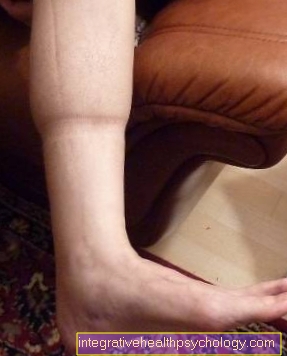

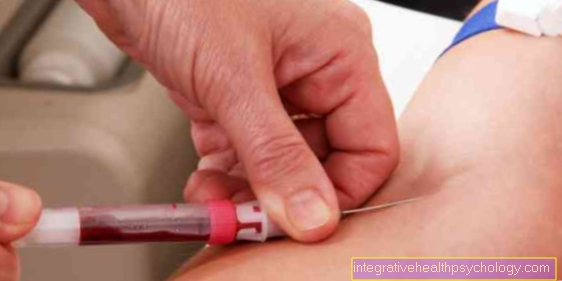





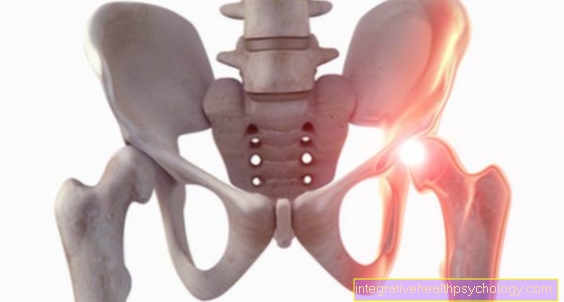



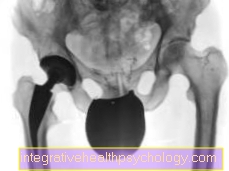
.jpg)
